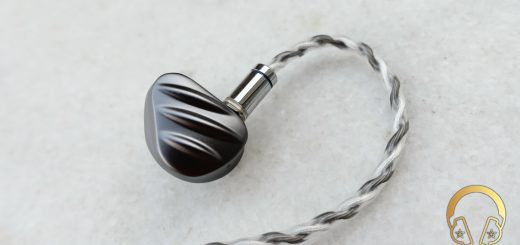Punch Audio Martilo Review
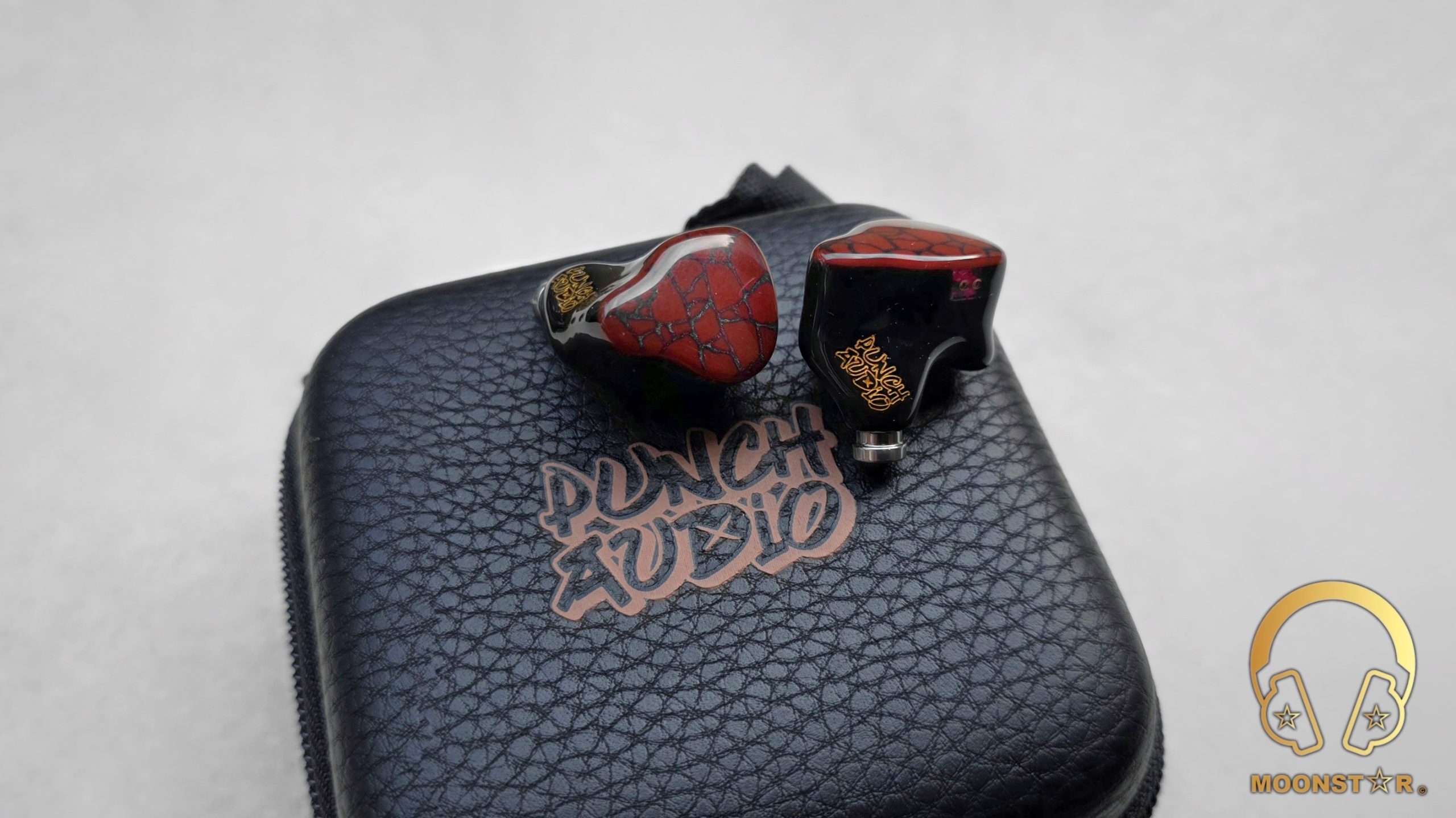
Punch Audio Martilo Review
Introduction:
Punch Audio has recently entered the audio market with the launch of the Martilo, an In-Ear Monitor introduced in June 2025. Purpose-built for listeners who prioritize impactful bass performance, the Martilo features a sophisticated hybrid driver configuration comprising a single planar driver, two Knowles RDE balanced armature drivers, and dual 8mm dynamic drivers. These components are housed in a 3D-printed resin shell, complemented by a bold red faceplate with black vein-like accents, blending visual flair with acoustic precision. The IEM also includes a detachable cable with a 0.78mm 2-pin connector interface and interchangeable plugs for added versatility.
This review will thoroughly explore the Punch Audio Martilo’s features and performance, offering personal impressions of this unique IEM.
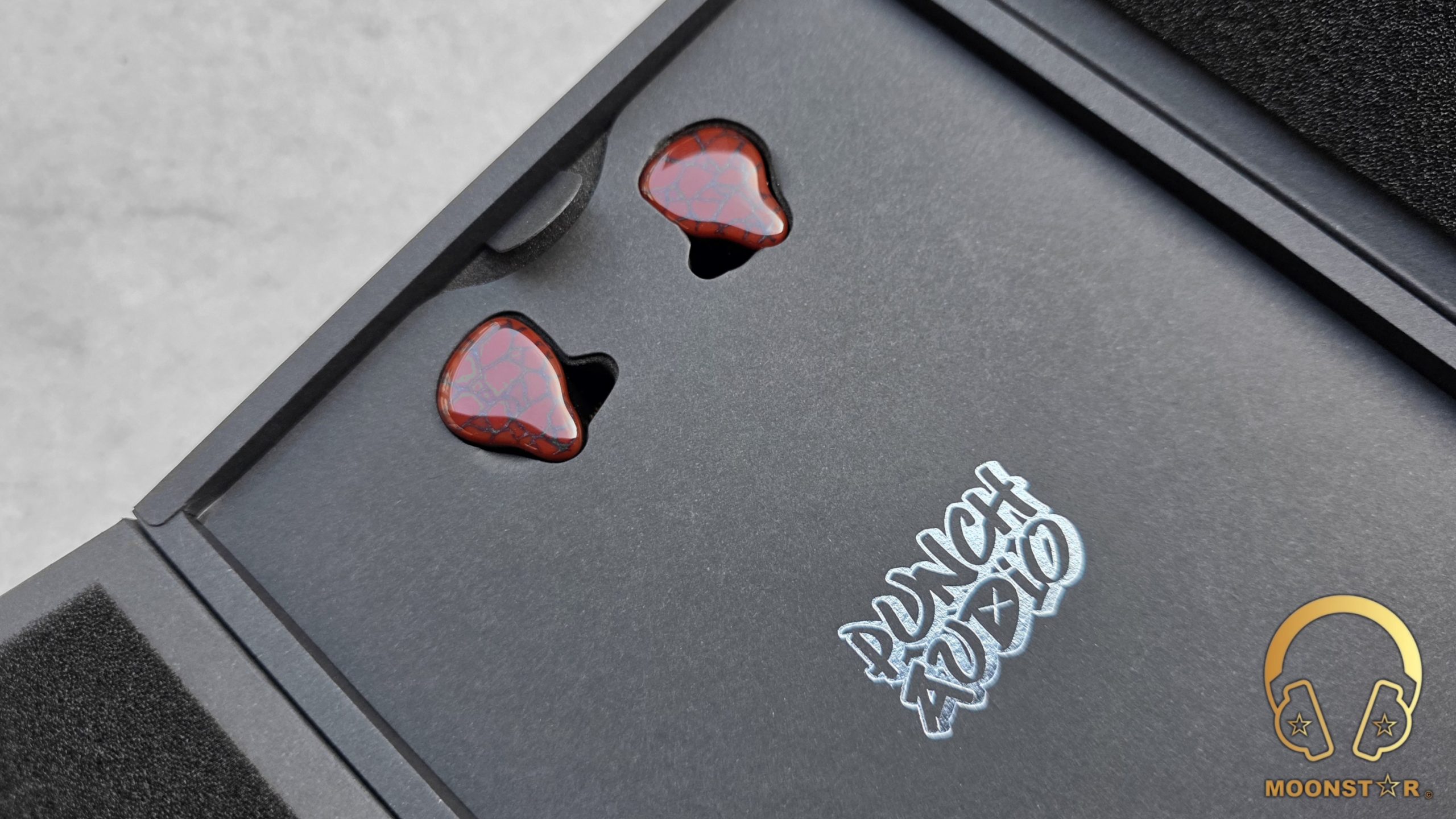
Disclaimer:
I would like to thank Linsoul and Punch Audio for providing the Martilo for review purposes. I am not affiliated with Linsoul or Punch Audio beyond this review and these words reflect my true and unaltered opinions about the product.
Price & Availability:
The Punch Audio Martilo carries a manufacturer’s suggested retail price (MSRP) of $329.00 USD. Further information can be found at the provided link.
Package & Accessories:
The Punch Audio Martillo In-Ear Monitors are housed in a compact black box, featuring the red, web-patterned in-ear monitors on the front, breaking through a shattered glass design. This bold and striking presentation is completed by the Punch Audio logo and “MARTILLO IN-EAR MONITORS” branding, along with small feature icons.
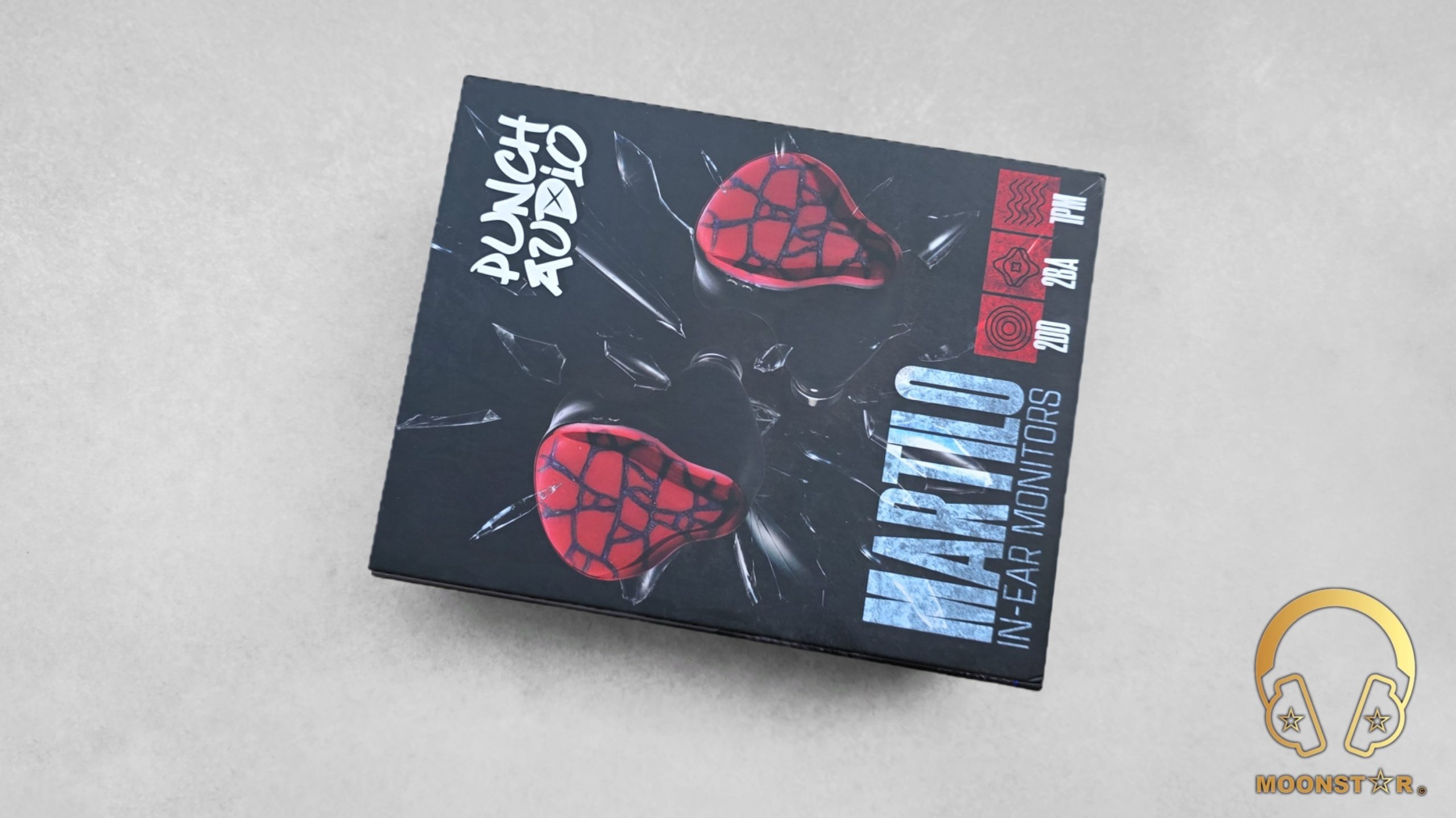
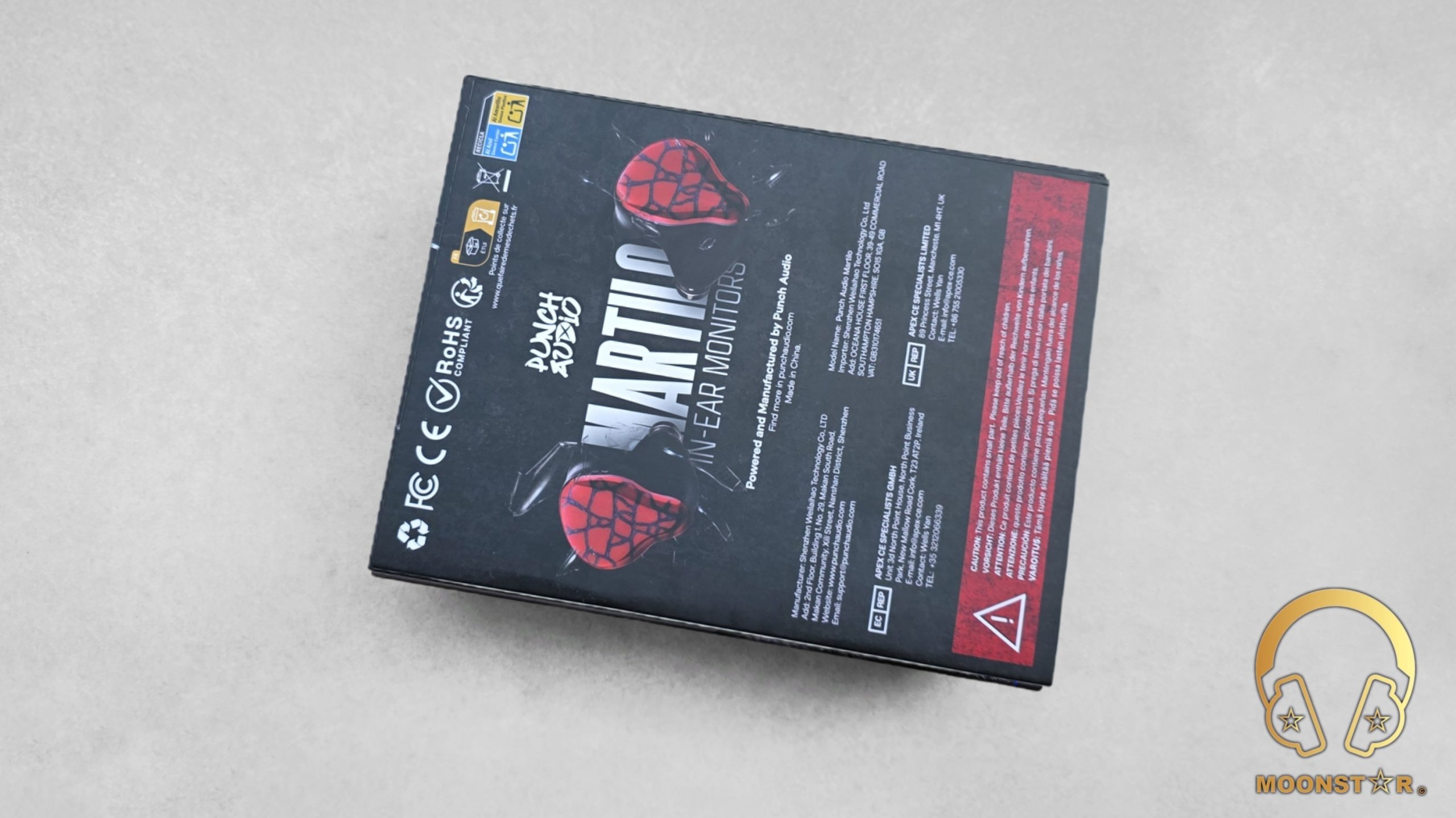

Inside the box are the following contents/accessories;
- 1 pair x Pair Punch Audio Martilo In-Ear Monitor
- 1x Detachable Cable with 0.78mm 2-Pin Connector Interface and Interchangeable Plugs
- 1x 3.5 mm Plug Adapter
- 1x 4.4 mm Plug Adapter
- 3 pairs x Silicone Ear Tips
- 3 pairs x Foam Ear Tips
- 2 sets x Nozzle Filters
- 1x Earphone Case
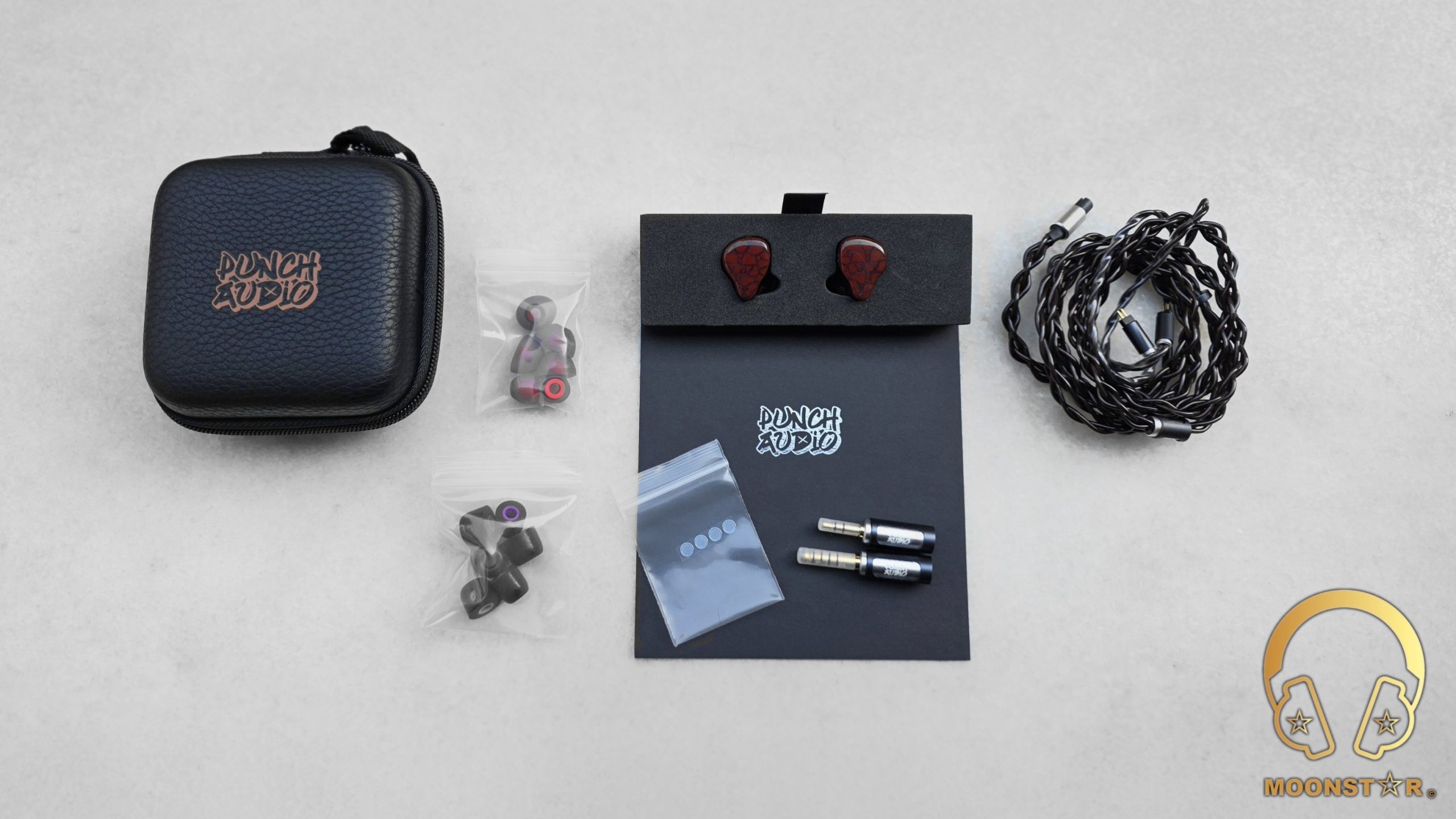

Design & Build Quality:
A key design element of the Punch Audio Martilo is its 3D-printed faceplate. Finished in red with black, vein-like patterns, it evokes the texture of natural stone. The glossy surface subtly shifts in appearance as it catches the light, creating visual interest, but the overall design remains more practical than ornate.

The faceplate’s shape aligns with the ear’s contour, contributing to both aesthetics and comfort.

At the top, the connector interface employs a 0.78mm 2-pin design that shows a firm connection for cable swaps.

The inner surface shows the L/R markings and features the sound nozzle, which has a triple acoustic duct system to support the hybrid driver setup. The surrounding resin is smooth, aiding in a comfortable fit against the ear canal.

Notably, the nozzle edge is marked with “PUNCH AUDIO” in yellow text, adding a branded touch, while the tip is covered with a metal mesh that likely aids in sound refinement and debris protection.

The rear top section includes a pressure-balanced port for the dynamic drivers, subtly integrated into the black resin shell to maintain airflow and performance. The 3D-printed resin construction is lightweight and durable, suitable for regular use, with a design that balances practicality and structural integrity without leaning toward excessive embellishment.

Detachable Cable:
The Martilo comes with a 4-core “Silver-Plated Copper” wire detachable cable, featuring a relative thick dark brown insulation. It measures approximately 125cm in length and has a braided design. The cable is moderately stiff, but doesn’t cause any notable microphonics during movement.

The cable is terminated with modular plugs, including a 3.5mm single-ended and a 4.4mm balanced option, both housed in sturdy metal connectors that ensure a secure fit.

The 0.78mm 2-pin connectors at the IEM end are color-coded (typically red for the right channel and clear for the left) and fit snugly into the Martilo’s interface, with a slight strain relief to reduce wear.
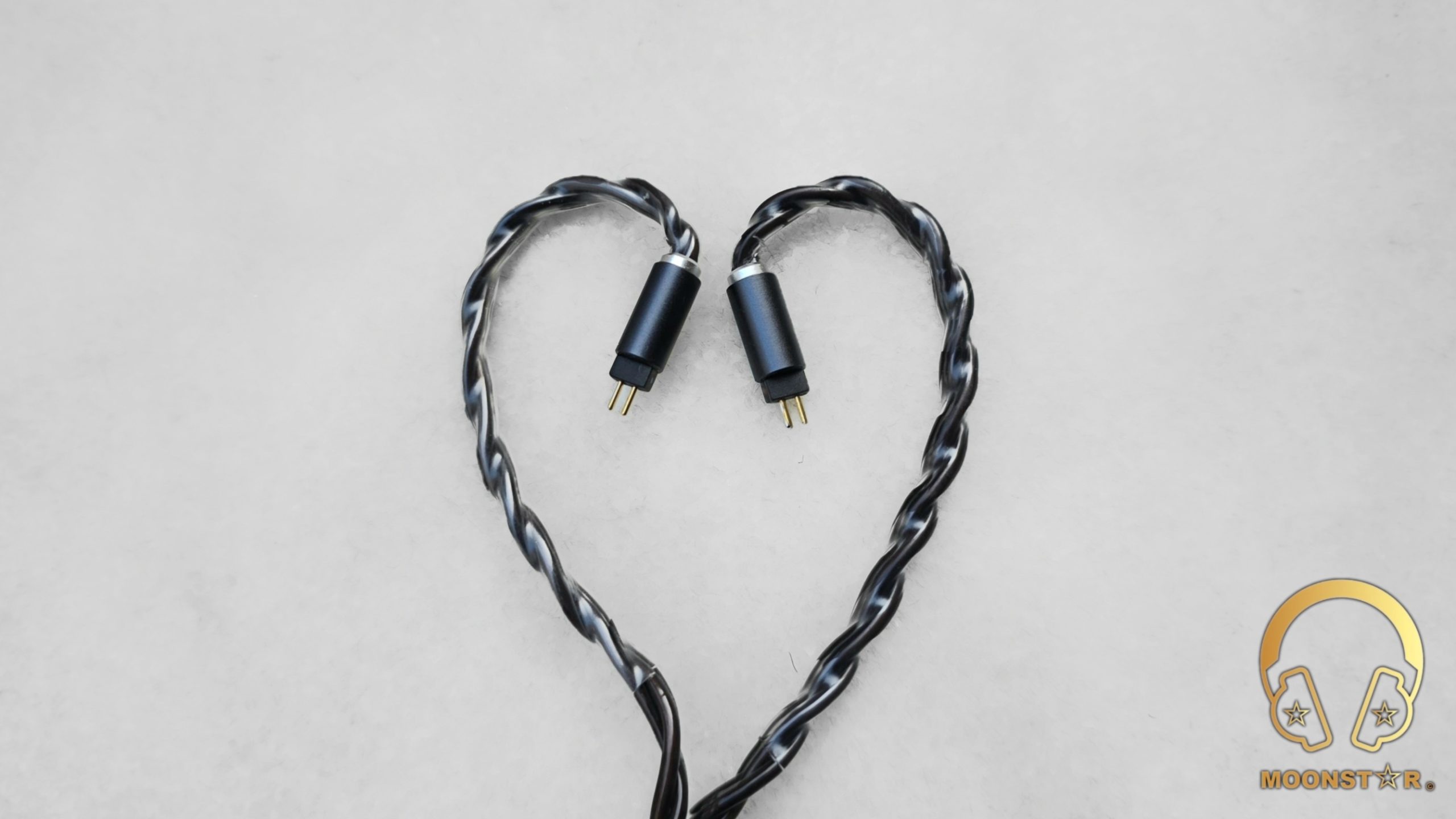
Overall, it’s a functional and durable accessory that supports the IEM’s performance without standing out as a premium upgrade.

Fit, Comfort & Isolation:
The Martilo’s ergonomic shell fits well within my moderately sized ear concha, offering stability during extended listening sessions without causing discomfort. Using the silicone ear tips, it provides effective passive noise isolation, reducing ambient sound sufficiently for commuting or focused listening. The foam ear tips increase isolation further, though they may slightly modify the sound profile. Adjusting the tip size allows for a customized fit, enhancing overall comfort and seal.

Technical Specifications:
- Model: Martilo
- Driver Configuration: 1 Planar + 2 Balanced Armature (Knowles RDE) + 2 Dynamic Drivers
- Frequency Response: 10Hz – 22kHz
- Sensitivity: 100dB @ 1kHz
- Impedance: 9Ω @ 1kHz
- Cable Material: 4-Core Silver-Plated Copper
- Connector Type: 0.78mm 2-Pin
- Modular Plugs: 3.5mm, 4.4mm
- Cable Length: approx.. 125cm
Drivability & Pairing:
With a 9Ω impedance and 100dB sensitivity, the Martilo is easily driven, performing well with the FiiO JM21 and HiBy R3Pro II DAPs used for this review. Both devices powered the IEM adequately, with the FiiO JM21 delivering a neutral and detailed output, while the HiBy R3Pro II introduced a slightly warmer tone that complemented the bass. A more powerful source could enhance its dynamic range, but it remains versatile with these portable players, making it suitable for on-the-go listening.

Equipment’s used for this review:
- IEM’s : Punch Audio Martilo, IO Audio Sogno
- DAP&DAC’s : FiiO JM21, HiBy R3Pro II
Albums & tracks used for this review:
- Norah Jones – Come Away With Me (Apple Music Lossless)
- Adele – My Little Love (Apple Music Lossless)
- Sarah McLachlan – Angel (Flac 24bit/48kHz)
- Sertap Erener – Aşk (Flac 16bit/44.1kHz)
- Edith Piaf – Non Je Ne Regrette Rien (Flac 16bit/44.1kHz)
- Diana Krall – So Wonderful (DSF)
- Aretha Franklin – I Say A Little Payer (Flac 24bit/96kHz)
- Michael Jackson – Billie Jean (Flac 24bit/96kHz)
- George Michael – Don’t Let the Sun Go Down on Me (Flac 24bit/192kHz)
- David Bowie – Heroes (Flac 24bit/192kHz)
- Elton John – Rocket Man ((Flac 24bit/96kHz)
- Barry White – Just The Way You Are (Flac 24bit/48kHz)
- Isaac Hayes – Walk On By (Flac 16bit/44.1kHz)
- Sting – Englishman in New York – (Flac 24bit/48kHz)
- Eric Clapton – Wonderful Tonight (Flac 24bit/96kHz)
- Dave Gahan – Kingdom (Tidal Hi-Fi)
- Radiohead – Live in Berlin “Album” (Apple Music Lossless)
- Radiohead – Pyramid Song (Apple Music Lossless)
- U2 – Sunday Bloody Sunday (Flac 16bit/44.1kHz)
- Muse – Hysteria (Flac 24bit/96kHz)
- Red Hot Chili Peppers – Nobody Weird Like Me (Flac 24bit/48kHz)
- Michael Jackson – Billie Jean (Flac 24bit/96kHz)
- Bear McCreary’s – Valkyries (Deezer HiFi)
- Bro Safari, UFO! – Drama (Deezer HiFi)
- Armin Van Buuren – Vini Vici (Flac 16bit/44.1kHz)
- Daft Punk – Instant Crush (Flac 24bit/96kHz)
- Daft Punk – Doin’ it Right (Flac 24bit/96kHz)
- Lorde – Royals (Flac 24bit/48kHz)
- Massive Attack – Angel (Flac 24bit/48kHz)
- Toutant – Rebirth (Deezer HiFi)
- Gogo Penguin – Raven (Flac 24bit/192kHz)
- Gogo Penguin – Murmuration (Flac 24bit/192kHz)
- Portishead – It Could Be Sweet (Apple Music Lossless)
- Hans Zimmer – The Dark Knight OST (Flac 24bit/96kHz)
- Max Richter – On the Nature of Daylight (Flac 24bit/96kHz)
- Charly Antolini – Duwadjuwandadu (Flac 24bit/192kHz)
- Tchaikovsky – Symphony No. 5 (Flac 16bit/44.1kHz)
- Ferit Odman – Look, Stop & Listen (Flac 24bit/192kHz)
- Chopin – Nocturn No. 20 In C-Sharp Minor (Flac 16bit/44.1kHz)
- Clair de Lune – Claude Debussy (Spotify)
- Fazıl Say – Nazım Oratoryosu (Live) (Flac 16bit/44.1kHz)
- Vivaldi – Le QuarttroStagioni “The Four Season” (Apple Music Lossless)
- Pink Floyd – Shine On You Crazy Diamond (Apple Music Lossless)
- Miles Davis – So What (Deezer HiFi)
- Otto Liebert& Luna Negra – The River (Flac 24bit/192kHz)
- Lunatic Soul – The Passage (Flac 16bit/44.1kHz)
- Deftones – My Own Summer (Shove it) (Flac 16bit/44.1kHz)
- Metallica – Dyers Eve (Flac 24bit/96kHz)
- Metallica – Sad but True (Flac 24bit/96kHz)
- Opeth – Windowpane (Flac 16bit/44.1kHz)
- Megadeth – Sweating Bullets (Tidal Hi-Fi)
- Rush’s – Tom Sawyer (Flac 16bit/44.1kHz)
- Slayer – Angel of Death (Spotify)
- Liquid Tension Experiment 2 – Acid Rain (Spotify)
- Yosi Horikawa – Bubbles (Spotify)

The Sound:
The Punch Audio Martilo delivers a sound signature with a pronounced emphasis on bass, while maintaining an overall character that leans toward the warm side of neutral. This balance ensures the bass doesn’t overpower the soundstage, allowing other frequencies to remain audible and distinct when needed. After a 50-hour burn-in period using the medium silicone ear tips and the 4.4mm cable, paired with the FiiO JM21 and HiBy R3Pro II, its audio profile stabilized, enabling a detailed assessment across a wide range of musical styles.

Bass
The two 8mm dynamic drivers are key to the Martilo’s bass, giving a strong and well-controlled low end. A big 14 ±1 dB sub-bass boost is a defining feature of this IEM. This tuning creates a deep and full base, clearest in electronic tracks like Armin Van Buuren’s “Vini Vici.” Here, the sub-bass provides a noticeable rumble, boosting the track’s energy, making it great for electronic music fans. The 200Hz crossover is vital for keeping things clear, stopping any major bleed into the mid-range. You can hear this in Gogo Penguin’s “Murmuration,” where the mid-bass adds a warm, punchy layer to the kick drum, supporting the jazz trio’s complex rhythms without making the sound muddy or crowded.
The bass hits fast and fades in a controlled way, handling quick basslines in tracks by artists like Daft Punk, such as “Doin’ it Right,” with impressive exactness. It also has a textured feel that makes hip-hop and EDM genres more engaging. In quieter, acoustic settings, the bass is still there but steps back nicely when the music calls for subtlety. This shows its flexibility, as its impact is felt but doesn’t hide delicate instrument work. This balance gets even better with the HiBy R3Pro II’s warmer output, which softens the bass’s edges, while the FiiO JM21’s neutral sound keeps it tight and clear. This confirms the Martilo’s bass is a strong point that improves the sound rather than overwhelming it, serving bass lovers well without losing overall balance.

Midrange:
The two Knowles RDE balanced armature drivers create a natural and connected midrange. This benefits from the warm, balanced sound that adds a bit of richness. The lower midrange provides a solid base for male vocals, as heard in Sting’s “Englishman in New York,” where the warmth adds body without being too thick, keeping the vocals grounded and expressive. The upper midrange brings female vocals forward, like Adele’s “My Little Love,” offering clarity and emotional depth without becoming harsh or sibilant. This quality shines particularly with the HiBy R3Pro II’s warmer sound, which gives a slightly smooth feel. Instruments like acoustic guitars in Eric Clapton’s “Wonderful Tonight” are played with good detail, their strums having a natural resonance that feels real.
Pianos in Chopin’s “Nocturne No. 20 In C-Sharp Minor” show a smooth and fairly detailed texture, highlighting key changes. The midrange gets a slight openness that helps with spatial awareness, creating a feeling of space in orchestral pieces like Tchaikovsky’s “Symphony No. 5.” However, it can sometimes be a bit overshadowed by the strong bass, especially with the FiiO JM21’s neutral sound, where the mids might feel a bit pushed back in bass-heavy songs. The HiBy R3Pro II’s warmer tone helps bring the midrange forward, suggesting that choosing the right source or listening to songs with strong midrange content can improve its presence. Still, it usually stays a secondary focus compared to the bass.

Treble:
The planar driver handles the treble, giving clear and quick high notes that match the warm, balanced sound, making sure it blends smoothly with lower frequencies. The lower treble accurately catches the shimmer of cymbals in Metallica’s “Sad but True,” providing sharp detail without causing listening fatigue over long periods. This quality stays consistent across both music players and works well for rock and metal. The upper treble extends with a subtle airiness, adding a sense of space to string sections in Vivaldi’s “Le Quattro Stagioni” (“The Four Seasons”). Here, the different layers of the orchestra are clear without being too bright, making classical music more enjoyable.
With the FiiO JM21, the treble stays neutral, showing small details like the gentle pluck of a harp in classical tracks or the sizzle of hi-hats in jazz pieces like Miles Davis’s “So What.” In contrast, the HiBy R3Pro II’s warmer sound softens the highs, reducing possible harshness in songs with a lot of high frequencies like U2’s “Sunday Bloody Sunday,” preventing any sharpness in vocal harmonies. The treble performance is generally steady but can vary a bit. Longer silicone ear tips or foam tips can make it smoother by lowering the emphasis on high frequencies, and the choice of source, especially the warmth of the HiBy R3Pro II, helps keep a good balance, stopping it from sounding too thin or too forward, especially in recordings sensitive to treble.

Soundstage & Imaging:
The Punch Audio Martilo’s soundstage offers a decent width and moderate depth, creating a clear three-dimensional listening area. Imaging is precise, with individual instruments placed accurately. This allows different layers to exist together without sounding cluttered. While it handles complex music well, it doesn’t have extreme width or height compared to some more expensive models. Imaging remains a strong feature, especially with the HiBy R3Pro II, improving where sounds come from across different music types.

Comparison:
Punch Audio Martilo versus IO Audio Sogno:
The Punch Audio Martilo’s bass is characterized by a powerful and controlled presentation, delivering a deep, resonant punch that stands as the IEM’s signature feature. The low end feels vibrant and textured, making it ideal for genres such as hip-hop and EDM where bass is central. Yet, it gracefully recedes in quieter tracks like acoustic music to maintain clarity. In contrast, the IO Audio Sogno’s bass offers a cleaner and more defined low end with good extension, providing a punchy yet less dominant feel that responds well to dynamic shifts. Its mid-bass lacks the Martilo’s robust authority, leaning towards a more restrained profile that better suits classical or instrumental tracks. For bass enthusiasts, the Martilo is the clear choice, while the Sogno appeals to those who prefer a more balanced low end.
The Martilo’s midrange is natural and cohesive, presenting a warm-leaning neutral tone. Vocals possess a rich and lifelike quality, and instruments like guitars and pianos are rendered with smooth detail. This inherent warmth adds an emotive layer, though it can be slightly overshadowed by the bass in certain tracks. The Sogno’s midrange, on the other hand, is detailed and transparent, with a slight emphasis in the upper mids. This delivers clear and prominent vocals, enhancing articulation, but might feel thinner and less warm. Pianos on the Sogno sound crisper yet less lush, offering a transparency that suits vocal clarity, whereas the Martilo’s warmer mids truly shine in jazz and acoustic genres.
Regarding treble, the Martilo’s is smooth and responsive, capturing details like cymbal shimmers and string nuances with a subtle airiness that prevents harshness, making it suitable for prolonged listening sessions across rock and classical music. The Sogno’s treble is energetic and airy, providing crisper instrument tones with a brighter edge that adds liveliness, all while remaining free of sibilance. The Sogno’s treble offers more detail but can feel less relaxed compared to the Martilo’s more forgiving nature. Consequently, the Martilo is better for those seeking smooth highs, while the Sogno is suitable for listeners desiring a more sparkling presentation.
The Martilo’s soundstage is respectable, offering good width and moderate depth and height. This creates a functional three-dimensional space where imaging is precise, allowing for clear instrument placement even in complex tracks. The Sogno’s soundstage is wide but lacks depth, presenting a more intimate sound with average imaging and separation, which feels less expansive. For orchestral or intricate compositions, the Martilo holds an advantage, while the Sogno performs well with vocal-focused or simpler arrangements.

Conclusion:
The Punch Audio Martilo stands out as an impressive option for audiophiles, especially those who prioritize a bass-centric listening experience without compromising overall sound quality. Its dynamic and controlled sound profile, powered by a hybrid configuration of planar and dynamic drivers, delivers a powerful low end that remains prominent while maintaining clarity across the midrange and treble. This makes it a versatile companion that performs commendably across genres such as hip-hop, EDM, OSTs, and even rock, particularly when paired thoughtfully. The robust 3D-printed resin shell, with its distinctive red faceplate and black vein patterns, not only ensures durability and comfort for extended listening sessions but also provides a unique aesthetic. While the treble and midrange may benefit from fine-tuning with different sources or ear tips to truly flourish, the IEM’s MSRP of $329.00 offers solid value for bass enthusiasts. Additionally, the included detachable cable, with its modular plugs and practical design, enhances the overall package by providing reliable connectivity and a subtle boost to sound transmission, further adding to its appeal.

Pros & Cons:
- + Powerful and well-controlled bass performance
- + Pretty clear and musical midrange with good sense of decent airiness
- + Precise treble with good extension
- + Surprisingly wide soundstage and pretty accurate imaging
- + Sturdy and comfortable 3D-printed shell
- + Versatile and useful accessory set
- + Functional detachable cable with interchangeable headphone plugs
- – Treble performance can vary depending on the source and ear tips used
- – Achieves best synergy with a neutral source
- – Not intended as a reference-grade IEM
Thank you for the Read!


